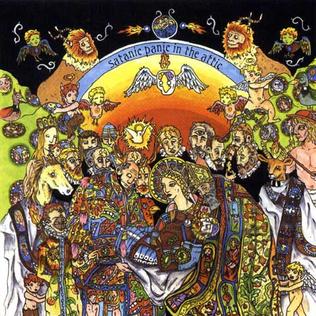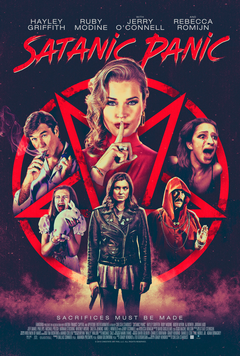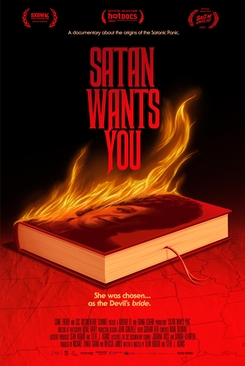See also
- Satanic Panic in the Attic , a 2004 album by Of Montreal
- Seven Inches of Satanic Panic , a 2019 EP by Ghost
The Satanic panic was a widespread moral panic in the United States in the 1980s, characterized by allegations of Satanic ritual abuse.
Satanic panic may also refer to:

The Church of Satan is a religious organization dedicated to the religion of LaVeyan Satanism as codified in The Satanic Bible. The Church of Satan was established at the Black House in San Francisco, California, on Walpurgisnacht, April 30, 1966, by Anton Szandor LaVey, who was the church's High Priest until his death in 1997. In 2001, Peter H. Gilmore was appointed to the position of high priest, and the church's headquarters were moved to Hell's Kitchen, Manhattan, New York City.
The Satanic panic is a moral panic consisting of over 12,000 unsubstantiated cases of Satanic ritual abuse starting in the United States in the 1980s, spreading throughout many parts of the world by the late 1990s, and persisting today. The panic originated in 1980 with the publication of Michelle Remembers, a book co-written by Canadian psychiatrist Lawrence Pazder and his patient, Michelle Smith, which used the discredited practice of recovered-memory therapy to make sweeping lurid claims about satanic ritual abuse involving Smith. The allegations, which afterwards arose throughout much of the United States, involved reports of physical and sexual abuse of people in the context of occult or Satanic rituals. In its most extreme form, allegations involve a conspiracy of a global Satanic cult that includes the wealthy and elite in which children are abducted or bred for human sacrifices, pornography, and prostitution.
A hidden message is information that is not immediately noticeable, and that must be discovered or uncovered and interpreted before it can be known. Hidden messages include backwards audio messages, hidden visual messages and symbolic or cryptic codes such as a crossword or cipher. Although there are many legitimate examples of hidden messages created with techniques such as backmasking and steganography, many so-called hidden messages are merely fanciful imaginings or apophany.

Lawrence Pazder was a Canadian psychiatrist and author. Pazder wrote the discredited biography, Michelle Remembers, published in 1980, with his patient Michelle Smith, which claimed to detail satanic ritual abuse.

Satanic Panic in the Attic is the sixth album released by the band Of Montreal. The album, like later albums The Sunlandic Twins and Hissing Fauna, Are You The Destroyer?, was made almost entirely by Kevin Barnes.
Satanic ritual may refer to:

Michelle Remembers is a discredited 1980 book co-written by Canadian psychiatrist Lawrence Pazder and his psychiatric patient Michelle Smith. A best-seller, Michelle Remembers relied on the discredited practice of recovered-memory therapy to make sweeping, lurid claims about Satanic ritual abuse involving Smith, which contributed to the rise of the Satanic panic in the 1980s. While the book presents its claims as fact, and was extensively marketed on that basis at the time, no evidence was provided; all investigations into the book failed to corroborate any of its claims, with investigators describing its content as being primarily based on elements of popular culture and fiction that were popular at the time when it was written.
Jonker is a Dutch surname. It is also a variation of the title jonkheer. The name can be occupational of origin, indicating an ancestor who was or worked for a jonkheer, or toponymical, e.g. referring to a house named De Jonker. People with the surname include:
Marc Selz is an American film director and producer. He specializes in horror/ slasher films.
Satanism is a belief or social phenomenon that features the veneration or admiration of Satan or a similar figure.
Satanic may refer to:
The Satanic panic in Utah is part of a broader moral panic that began in the 1980s as children in the United States, subjected to coercive interviewing techniques at the hands of zealous social workers, made unsubstantiated allegations of bizarre Satanic rituals and horrific sexual and physical abuse at the hands of day care workers. As the decade unfolded, clients of believing therapists began to make similar allegations, which are now generally seen as confabulations caused by iatrogenic therapeutic techniques such as hypnosis and automatic writing rather than the discovery of repressed memories. Despite the similarities between the allegations of adults and children, investigations produced only circumstantial, and in many cases contradictory evidence of the patients' disclosures. The court cases surrounding SRA allegations were among the most expensive and lengthy in history and produced no convictions or convictions based solely on the testimony of children that were frequently overturned or dismissed upon appeal.
Sean Horlor is a Canadian film director, film producer, poet, actor, television producer, columnist and blogger, who co-directs with Steve J. Adams under their production company, Nootka St.
The Satanic panic is a moral panic about alleged widespread Satanic ritual abuse which originated around the 1980s in the United States, peaking in the early 1990s, before waning as a result of scepticism of academics and law enforcement agencies who ultimately debunked the claims. The phenomenon spread from the United States to other countries, including South Africa, where it is still evident periodically. South Africa was particularly associated with the Satanic panic because of the creation of the Occult Related Crimes Unit in 1992, described as the "world's only 'ritual murder' task force". According to anthropologist Annika Teppo, this was linked with powerful conservative Christian forces within the then-dominant white community in the last years of apartheid. Christian belief is a prerequisite to serve in the unit. The concern with the alleged presence of Satanism and occult practices has continued into the post-apartheid era.

The Satanic Temple (TST) is a non-theistic religious organization that is primarily based in the United States, with additional congregations in Canada, Australia, Finland, Germany and the United Kingdom. Co-founded by Lucien Greaves, the organization's spokesperson, and Malcolm Jarry, the organization uses Satanic imagery to promote egalitarianism, social justice, and the separation of church and state, supporting their mission "to encourage benevolence and empathy [among all people]." The Satanic Temple has utilized satire, theatrical ploys, humor, and legal action in their public campaigns to "generate attention and prompt people to reevaluate fears and perceptions", and to "highlight religious hypocrisy and encroachment on religious freedom."

Douglas Mesner, better known as Lucien Greaves, is a social activist and the spokesman and co-founder of The Satanic Temple.

Satanic Panic is a 2019 American comedy horror film directed by Chelsea Stardust, based on a screenplay written by novelist Grady Hendrix and adapted from a story created by Hendrix and Ted Geoghegan. It is a Fangoria production.

Hail Satan? is a 2019 American documentary film about The Satanic Temple, including its origins and grassroots political activism. Directed by Penny Lane, the film premiered at the 2019 Sundance Film Festival, and was released in the United States on April 19, 2019, distributed by Magnolia Pictures. The film shows Satanists working to preserve the separation of church and state against the privileges of the Christian right.

Seven Inches of Satanic Panic is a release by the Swedish rock band Ghost. First released digitally on 13 September 2019 by Loma Vista Recordings, it features the songs "Kiss the Go-Goat" and "Mary on a Cross", written by vocalist Tobias Forge along with songwriters Salem al Fakir and Vincent Pontare. It was later released on 7" vinyl. Seven Inches of Satanic Panic has been described as a two-track EP and as a single.

Satan Wants You is a 2023 Canadian documentary film directed by Steve J. Adams and Sean Horlor. The film profiles the Satanic panic hoax of the early 1980s, centring in particular on the history of the discredited book Michelle Remembers. It also focuses in part on how the Satanic panic significantly targeted LGBTQ people, and illustrates parallels to contemporary hoaxes such as QAnon, Pizzagate and the LGBT grooming conspiracy theory.